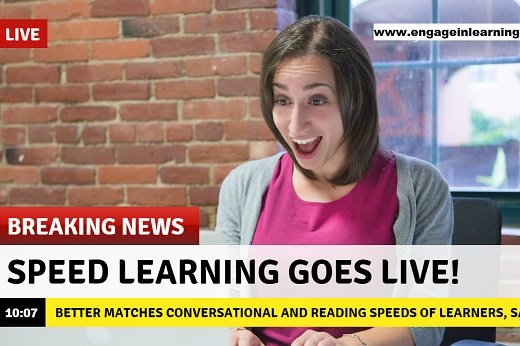Speed-learning function hits the eLearning market

..opening the doors for brain-optimisation in online training
Listeners of podcasts and audiobooks have been known to use digital devices that can accelerate the speed of narration without increasing the pitch. In fact, busy listeners are speeding up podcasts and claiming full comprehension at speeds of up to five times normal. This technology is exactly what developers at Engage in Learning have now introduced into their eLearning training courses.
While on holiday in July 2017, Engage in Learningʼs Managing Director, Chris Horseman, came across the Times article which struck a chord with him as it related to something he was already doing himself, listening to audio books and podcasts at high speed to save time. He emailed this to his senior software developer who rapidly created a prototype of one of their eLearning courses running at speeds up-to twice normal. They also factored in the need to adjust down the pitch of the voice so it sounds like the narrator is simply speaking faster.
Allowing the learner to change the playback speed, to go faster or slower at any time — even while the content is playing — was an interesting challenge; much more had to be considered than just the speed of the audio and video: animations, progress feedback, and even the transcript all needed their timings recalculated in real-time to match the new playback rate.
- The intent is to allow learners to control the speed of their online training course up to twice the normal speed while retaining full comprehension.
- By synchronising the animations and transcript so they run twice as fast along with the audio means the entire course experience continues to make sense but takes half the time to take in.
Professional narrators speak at around 150 words per minute, compared with speeds of up to 200 words in ordinary conversation. When people read something aloud for others, they tend to speak 20-30 per cent slower than in conversation, although many listeners want that conversational, classroom feeling, so they can now bump up the speed slightly. An additional benefit of this function is because the transcript runs twice as fast, the reading experience is much closer to the average reading speed of around 200-300 words per minute too. This means “read-only” learners wonʼt feel they are having to wait around.
Engage in Learningʼs Marketing Communications Manager, James Morelli-Green, said “Our Speed-Learning function now facilitates a more engaging learning experience which better matches conversational and reading speeds of learners. Speed-learning enabled, multi-lingual, 24/7 accessibility puts learners in control and ensures training that best suits their own timetables with no constraint on productivity and resources”.
Tags: Award Winning, eLearning, Learning & Development, Staff Training
